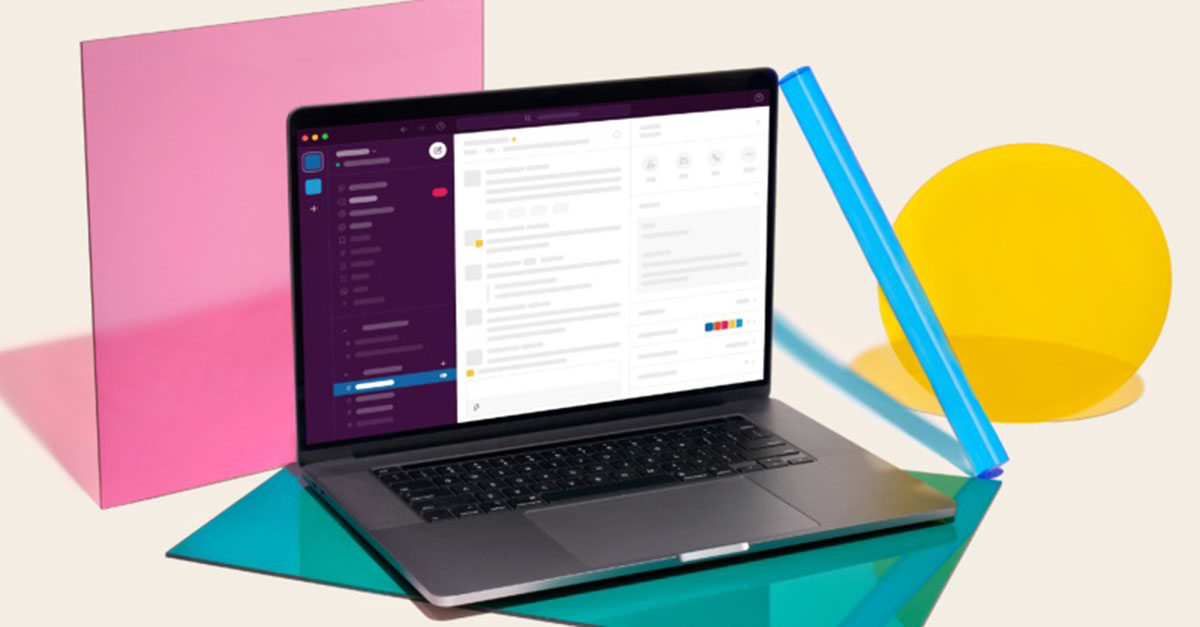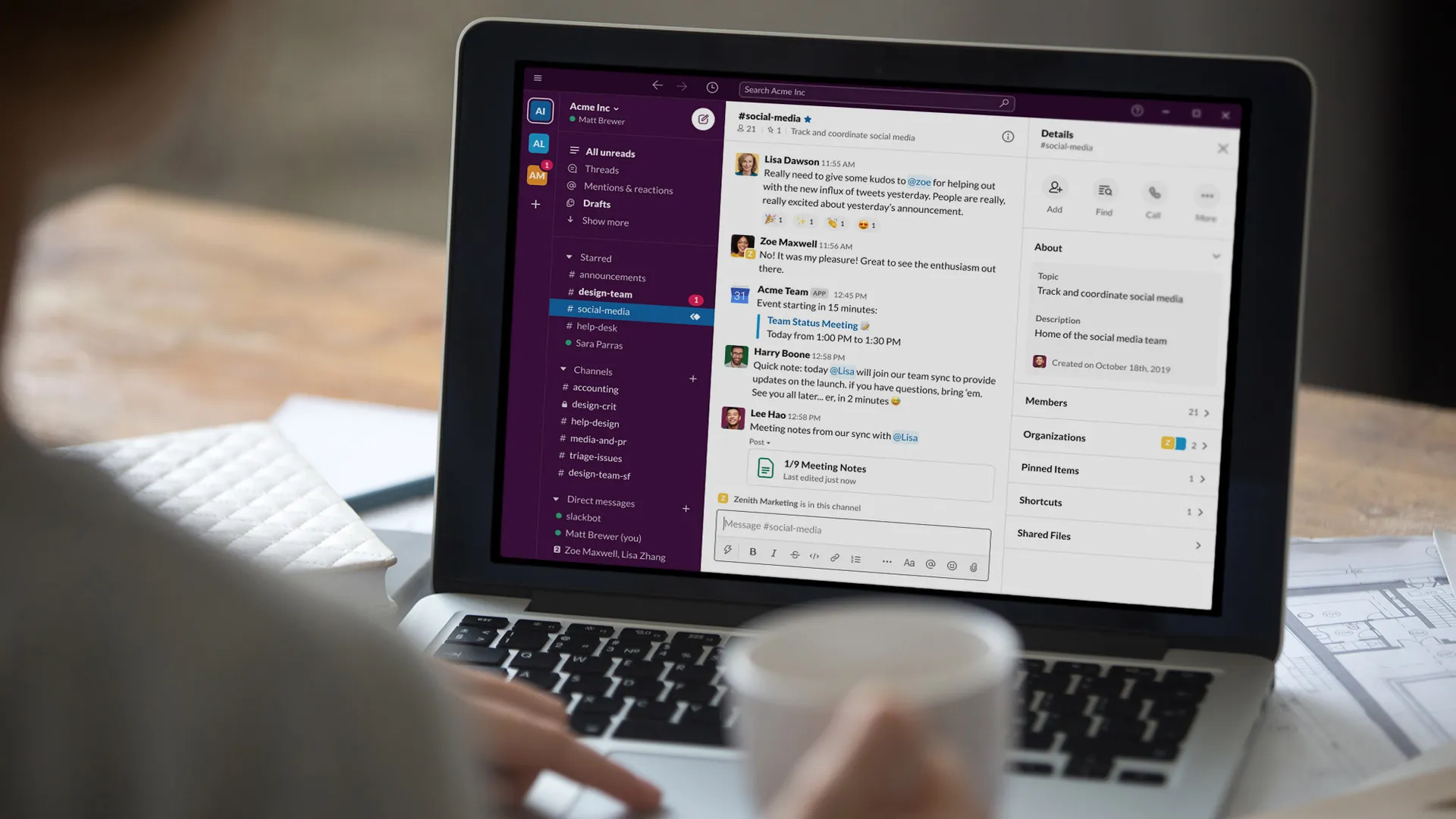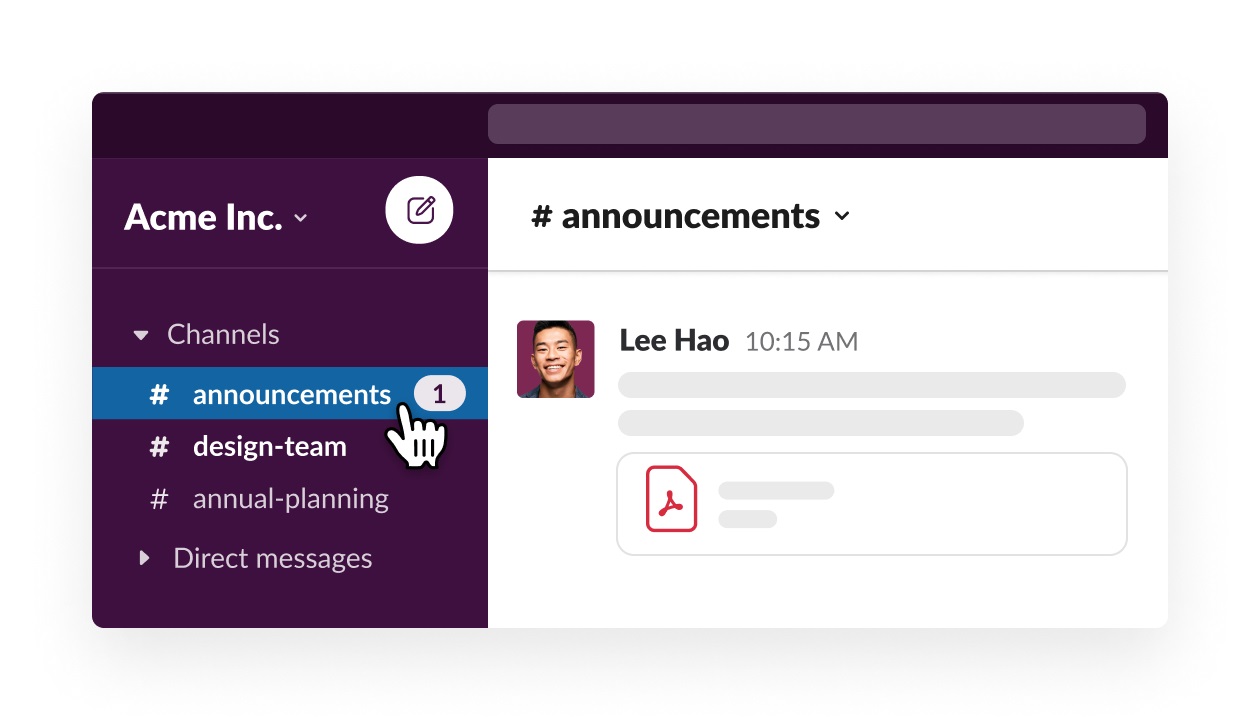Introduction
Welcome to the world of Slack, a popular team communication and collaboration tool that has revolutionized the way teams work together. It offers a seamless and efficient way to connect, share information, and stay organized. However, keeping Slack active and engaging can sometimes be a challenge. In this article, we will explore various strategies to ensure that your Slack channel remains vibrant and fosters active participation.
Slack is more than just a messaging platform; it can be a hub for collaboration, creativity, and productivity. By encouraging active participation, setting clear goals and expectations, providing regular updates and announcements, using integrations and bots, organizing fun and engaging activities, fostering a supportive community, promoting knowledge sharing, keeping communication channels relevant and organized, and recognizing and rewarding active members, you can maintain an active Slack channel that adds value to your team.
Whether you are a team leader, a community manager, or a member of a Slack workspace, the strategies outlined in this article will help you create an engaging and dynamic virtual environment where team members feel connected, motivated, and eager to contribute.
So, let’s dive in and discover how to keep Slack active and make the most of this powerful communication tool!
Encourage Active Participation
One of the key elements in keeping Slack active is to foster a culture of active participation among team members. Here are some effective strategies to encourage engagement:
- Create a Welcoming Environment: Make sure that team members feel comfortable and welcomed in the Slack channel. Encourage open communication, respect diverse opinions, and create a safe space for everyone to share their thoughts.
- Lead by Example: As a team leader or community manager, actively participate in the channel and set the tone for engagement. Share updates, ask questions, and initiate discussions to encourage others to do the same.
- Ask Thought-Provoking Questions: To spark engagement and initiate conversations, ask thought-provoking questions related to the team’s work, industry trends, or even fun topics. Encourage team members to share their insights and experiences.
- Highlight and Acknowledge Contributions: Acknowledge and appreciate team members’ contributions by highlighting their achievements, ideas, or helpful insights. This recognition not only motivates individuals but also encourages others to actively participate.
- Encourage Collaboration: Use Slack channels to promote collaboration and teamwork. Create specific channels for project discussions, brainstorming, or cross-departmental collaboration, and encourage team members to actively participate in these channels.
- Provide Constructive Feedback: Constructive feedback is invaluable in promoting active participation. Encourage team members to give feedback on projects, share their ideas on how to improve processes, and provide suggestions for growth. This feedback loop fosters continuous engagement and improvement.
- Set Expectations for Response Time: Clearly communicate the expected response time for messages in the Slack channel. This helps team members understand the urgency and importance of timely participation.
- Organize Regular Check-ins: Schedule regular check-ins or status updates to review progress, address challenges, and encourage team members to actively participate in these discussions.
By implementing these strategies, you can create a culture of active participation where team members feel valued, engaged, and motivated to contribute their ideas and expertise in the Slack channel.
Set Clear Goals and Expectations
To keep Slack active and productive, it’s important to establish clear goals and expectations for team members. Here’s how you can do it:
- Define the Purpose of the Slack Channel: Clearly communicate the purpose of the Slack channel to team members. Whether it’s for project collaboration, knowledge sharing, or general communication, ensure that everyone understands the main objective.
- Specify Communication Guidelines: Establish guidelines for communication in the Slack channel. This can include expectations for language, tone, and professional conduct. Encourage respectful and constructive discussions while discouraging any form of harassment or inappropriate behavior.
- Set Expectations for Frequency of Updates: Specify how frequently team members should provide updates or share information in the Slack channel. This helps create a rhythm of communication and ensures that important updates are not missed.
- Create Clear Channels: Organize channels based on specific topics, projects, or departments. This helps in categorizing conversations and ensures that discussions remain focused and relevant. Clearly communicate the purpose of each channel to avoid confusion.
- Establish Response Time Expectations: Determine the expected response time for messages in the Slack channel. This varies depending on the urgency and nature of the communication, but having clear expectations enables effective collaboration and avoids delays.
- Align Slack Usage with Team Goals: Connect the usage of Slack with the broader goals and objectives of the team. Link the communication in Slack to specific projects, deadlines, or initiatives to emphasize its importance and relevance.
- Regularly Review and Revisit Goals: It’s crucial to periodically review goals and expectations to ensure they are still relevant and aligned with the team’s evolving needs. Make adjustments and communicate any changes to team members.
- Seek Feedback: Regularly ask for feedback from team members on the effectiveness of the goals and expectations set for the Slack channel. This helps in identifying areas for improvement and ensures that the communication platform continues to meet the team’s needs.
By setting clear goals and expectations, you provide a framework for team members to understand their responsibilities and the purpose of Slack communication. This clarity fosters active participation and a focused approach towards achieving common objectives.
Provide Regular Updates and Announcements
Keeping team members informed and updated through regular announcements and updates is crucial to maintaining an active Slack channel. Here’s how you can effectively provide regular updates:
- Establish a Communication Schedule: Set a regular schedule for providing updates and announcements in the Slack channel. This could be a weekly or biweekly update or a daily roundup of key information. Consistency is key in keeping team members engaged.
- Use @mentions: When sharing important updates or announcements, use @mentions to notify relevant team members. This ensures that the right people are aware of the information and can actively participate in the discussion if needed.
- Be Clear and Concise: When delivering updates and announcements, keep them clear, concise, and to the point. Avoid unnecessary information or jargon that may confuse or overwhelm team members.
- Provide Relevant Context: When sharing updates, provide the necessary context to help team members understand the significance and relevance of the information. This could include background information, project updates, or any dependencies that may impact their work.
- Include Visuals or Multimedia: Where appropriate, include visuals such as charts, graphs, or screenshots to enhance the understanding and engagement of team members. Visuals can help convey complex information more effectively.
- Encourage Feedback and Q&A: Create a space for team members to ask questions or provide feedback on the updates and announcements. This encourages active participation and ensures that everyone has a chance to clarify any doubts or share their thoughts.
- Segment Updates by Channels: If your team has multiple ongoing projects or areas of focus, segment updates by channels. This allows team members to easily find the information relevant to their work and filters out unnecessary noise.
- Make Use of Pinning Feature: Pin important updates or announcements in the channel to ensure they remain easily accessible to team members. This prevents the information from getting buried in the conversation thread.
- Schedule Reminders: If there are important dates, deadlines, or events coming up, schedule reminders in Slack to keep team members informed and engaged. This ensures that important information doesn’t get overlooked.
By providing regular updates and announcements, you keep team members informed about key developments, foster transparency, and encourage active participation in the Slack channel. This leads to a more engaged and connected team.
Use Integrations and Bots
Integrating various tools and utilizing bots in your Slack workspace can significantly enhance productivity, streamline workflows, and keep the channel active. Here are some ways you can leverage integrations and bots:
- Connect Workflow Tools: Integrate project management tools, task trackers, or calendar apps with Slack. This allows team members to receive automated updates, notifications, and reminders directly in the Slack channel, keeping everyone informed and on track.
- Automate Routine Tasks: Use Slack bots to automate repetitive tasks, such as scheduling meetings, setting reminders, or sharing daily status updates. This frees up time for team members to focus on more meaningful work and facilitates active participation by reducing administrative burdens.
- Integrate File Sharing and Collaboration Tools: Connect file sharing and collaboration tools, such as Google Drive or Dropbox, with Slack. This enables seamless sharing of files, documents, and project updates, promoting collaboration and encouraging team members to participate in discussions surrounding these shared resources.
- Enable Polls and Surveys: Use integration tools or bots to create and share polls or surveys within Slack. These interactive features engage team members and provide an opportunity for active participation, as they can voice their opinions or preferences on various topics.
- Integrate Knowledge Management Systems: Connect knowledge management systems, such as Confluence or SharePoint, with Slack. This allows team members to search for and access relevant documentation or resources directly from Slack, encouraging knowledge sharing and facilitating active participation.
- Utilize Notifications: Set up custom notifications for specific events, such as mentions in specific channels or keywords relevant to a team member’s role. This ensures that individuals stay informed about relevant conversations and can actively participate as needed.
- Enable Metrics and Analytics: Utilize integrations or bots that provide analytics and metrics related to team performance, engagement, or productivity. Sharing these insights in the Slack channel encourages discussion, goal setting, and active participation in driving team success.
- Create Custom Integrations: If there are specific tools or systems your team uses, explore the possibility of creating custom integrations that suit your unique needs. Custom integrations can streamline workflows, centralize information, and encourage active participation by bringing all necessary data into the Slack channel.
By leveraging integrations and bots, you can enhance collaboration, automate tasks, and provide valuable functionalities in your Slack workspace. This not only keeps the channel active but also boosts overall productivity and efficiency for the entire team.
Organize Fun and Engaging Activities
While Slack is primarily a tool for work communication, incorporating fun and engaging activities can help foster a positive and vibrant atmosphere within the channel. Here are some ideas to organize activities that encourage active participation:
- Icebreaker Games: Start the week or month with icebreaker games to get team members interacting and building connections. This could be sharing interesting facts, playing trivia, or posting funny memes.
- Virtual Events: Organize virtual events such as team-building activities, happy hours, or themed days where team members can come together for interactive sessions, games, or discussions.
- Theme Days: Designate specific days of the week for fun themes or challenges. For example, “Throwback Thursday” where team members share old photos or memories, or “Tech Tip Tuesday” where members share useful tech tips and tricks.
- Collaborative Playlists: Create a dedicated channel where team members can share their favorite songs or create collaborative playlists. This encourages sharing and conversation around shared interests.
- Virtual Coffee Breaks: Set up specific times for virtual coffee breaks or informal chats where team members can socialize and discuss non-work-related topics. This creates a sense of camaraderie and encourages active participation during these casual interactions.
- Work-Related Challenges: Introduce challenges or competitions related to work tasks, such as design contests, caption competitions, or problem-solving challenges. This promotes engagement and encourages team members to actively participate in these activities.
- Recognition and Appreciation: Create channels or bots dedicated to recognizing and appreciating team members’ achievements, contributions, or milestones. This fosters a positive environment and encourages active participation in celebrating each other’s successes.
- Morning or End-of-Day Check-Ins: Start the day with a morning check-in channel where team members can share their goals or plans for the day. Similarly, create an end-of-day channel for team members to reflect on accomplishments or share interesting experiences from their day.
- Book or Movie Clubs: Form book or movie clubs within the Slack channel, where team members can discuss and share recommendations. This encourages participation and promotes a sense of shared interests beyond work.
- Trivia or Quiz Nights: Plan regular trivia or quiz nights in the Slack channel where team members can test their knowledge and compete in a friendly environment. This sparks engagement and active participation through interactive challenges.
By organizing fun and engaging activities, you create a lively and inclusive atmosphere in the Slack channel. These activities not only encourage active participation but also nurture relationships, boost morale, and promote a positive team culture.
Foster a Supportive and Inclusive Community
A supportive and inclusive community is crucial for maintaining an active and engaging Slack channel. Here’s how you can create such an environment:
- Encourage Respectful Communication: Emphasize the importance of respectful communication and create guidelines that promote inclusivity and understanding. Foster a culture where everyone feels comfortable expressing themselves without fear of judgment or discrimination.
- Establish Code of Conduct: Develop a code of conduct that explicitly outlines what behavior is acceptable and what is not. Communicate this code to all team members and hold individuals accountable for their actions.
- Embrace Diversity: Celebrate and value the diversity within your team. Encourage team members to share their unique perspectives, experiences, and cultural backgrounds. Actively seek out and promote diverse voices to ensure a well-rounded and inclusive community.
- Provide Resources and Support: Offer resources, such as employee assistance programs or diversity and inclusion training, to support team members in navigating various challenges. Create channels or bots dedicated to mental health, well-being, or resources that promote personal and professional growth.
- Facilitate Collaboration: Foster an atmosphere of collaboration and teamwork by encouraging cross-functional communication and providing opportunities for team members to work together on projects and initiatives.
- Listen and Respond: Actively listen to team members’ concerns, feedback, and suggestions. Respond promptly and transparently to their inquiries or requests, showing that their voices are valued and their input is taken seriously.
- Promote Appreciation and Recognition: Create channels or bots dedicated to appreciating and recognizing the efforts and achievements of team members. Encourage the practice of giving shoutouts and expressing gratitude for each other’s contributions.
- Encourage Empathy and Support: Foster an environment where team members can freely offer support, empathy, and understanding to one another. Creating designated channels for sharing personal achievements, challenges, or experiences can further promote a sense of community and a supportive culture.
- Address Conflict Constructively: Address conflicts or disagreements in a constructive and respectful manner. Provide appropriate channels for resolving conflicts and encourage open dialogue to reach resolutions.
- Provide Learning Opportunities: Organize webinars, workshops, or training sessions to educate team members on topics such as diversity, inclusion, and unconscious bias. Encourage ongoing learning and growth to foster a more inclusive community.
By fostering a supportive and inclusive community, you create an environment where all team members feel valued, respected, and empowered to actively participate in discussions and initiatives within the Slack channel. This sense of community strengthens bonds, generates collaboration, and drives overall engagement.
Promote Knowledge Sharing and Learning
A thriving Slack channel is one where knowledge is shared, and learning is actively promoted. Fostering a culture of continuous learning not only keeps team members engaged but also encourages personal and professional growth. Here’s how you can promote knowledge sharing and learning within your Slack channel:
- Create Dedicated Knowledge-Sharing Channels: Establish specific channels where team members can share useful articles, resources, or insights related to their respective areas of expertise. Encourage others to ask questions and engage in discussions around these topics.
- Encourage Subject Matter Experts: Identify team members who possess expertise in certain areas and encourage them to share their knowledge with others. Encourage these subject matter experts to host presentations, workshops, or Q&A sessions within the Slack channel.
- Host Webinars or Virtual Learning Sessions: Organize webinars or virtual learning sessions on specific topics of interest. Invite external speakers or internal experts to deliver these sessions and provide opportunities for team members to engage and ask questions.
- Share Industry News and Insights: Regularly post relevant industry updates, news articles, or insights in the Slack channel. Encourage team members to discuss these developments and share their thoughts or opinions.
- Provide Learning Resources: Curate and share learning resources such as online courses, podcasts, or ebooks that align with the team’s interests and professional development goals. Foster a culture of continuous learning by making these resources easily accessible.
- Establish a Mentoring Program: Create a mentorship program within the Slack channel where experienced team members can mentor and support others. Encourage mentees to actively seek guidance and share their progress or learnings with the community.
- Encourage Pair Programming or Peer Review: Facilitate pair programming sessions or encourage team members to request peer reviews of their work within the Slack channel. This allows for knowledge sharing and constructive feedback, fostering growth and learning.
- Host AMA (Ask Me Anything) Sessions: Arrange Ask Me Anything sessions with leaders or experts within the company. These sessions provide a platform for team members to ask questions, gain insights, and learn from experienced individuals.
- Create a Library of Frequently Asked Questions: Maintain a central document or channel dedicated to frequently asked questions (FAQs) related to the team’s work, processes, or tools. Encourage team members to contribute to and reference this resource for quick and easy access to information.
- Recognize and Reward Knowledge Sharing: Acknowledge and appreciate team members who actively contribute to knowledge sharing. This can be through a recognition program or gamification where points or badges are awarded for sharing valuable insights or resources.
By actively promoting knowledge sharing and learning, you create a collaborative and growth-oriented environment within the Slack channel. Team members feel empowered to share their knowledge and continuously develop their skills, leading to enhanced engagement and a more knowledgeable team overall.
Keep Communication Channels Relevant and Organized
Keeping communication channels relevant and organized is essential for maintaining an active and efficient Slack channel. Here’s how you can ensure that the communication within your Slack workspace remains focused and well-structured:
- Create Specific Channels for Different Topics: Establish different channels for specific topics, projects, or departments. This helps in categorizing conversations and ensures that discussions remain focused and relevant. Clearly communicate the purpose of each channel to avoid confusion.
- Review and Archive Unused Channels: Periodically review the channels in your Slack workspace and archive any that are no longer active or relevant. This helps declutter the channel list and ensures that important conversations do not get lost among unused channels.
- Encourage Channel Descriptions: Ask channel owners to provide clear descriptions for each channel, outlining its purpose and guidelines. This helps team members identify the most appropriate channels for their discussions and prevents confusion.
- Promote Channel Etiquette: Establish channel etiquette guidelines that outline expected behavior and communication norms within each channel. Encourage team members to adhere to these guidelines to foster productive and respectful discussions.
- Encourage Tagging and Thread Usage: Train team members to use tags and threads when appropriate, especially in busy or high-traffic channels. This helps keep discussions organized and allows for easy navigation and follow-up on specific topics.
- Use Channel Filters and Favorites: Utilize Slack’s channel filters and favorites feature to customize your workspace view. Organize channels based on priority or relevance to easily access and engage in active discussions.
- Regularly Review Notification Settings: Encourage team members to review and adjust their notification settings based on their preferences and workload. This ensures that they receive notifications for important discussions while avoiding overwhelming noise.
- Establish Channel Moderators: Appoint channel moderators who can oversee discussions, maintain channel guidelines, and ensure conversations stay on topic. Moderators can also assist in answering questions, resolving conflicts, and fostering engagement.
- Provide Channel Guides or FAQs: Create channel guides or frequently asked questions (FAQs) to help team members understand the purpose, rules, and best practices of each channel. These resources serve as references and support a more organized and efficient communication flow.
- Regularly Communicate Updates and Changes: Keep team members informed about any updates or changes in channel structures, guidelines, or etiquettes. Share this information in a centralized and easily accessible location, such as a dedicated documentation channel.
By keeping communication channels relevant and organized, you create a streamlined and productive environment within the Slack channel. Team members can easily find and engage in discussions that are relevant to their work, leading to increased collaboration and overall channel activity.
Recognize and Reward Active Members
Recognizing and rewarding active members within your Slack channel is a powerful way to foster engagement, motivation, and a sense of belonging. Here are some effective strategies you can implement to acknowledge and appreciate the contributions of team members:
- Publicly Acknowledge Contributions: Take the time to publicly recognize and appreciate team members’ efforts, achievements, or valuable contributions in a dedicated channel. Highlight their accomplishments and express gratitude for their active participation.
- Spotlight Member of the Month/Week: Create a tradition of recognizing and featuring a member of the month or week within the Slack channel. Share their achievements, contributions, and insights to inspire others and encourage active participation.
- Implement a Badge or Points System: Introduce a badge or points system where team members earn recognition for their active involvement. Assign badges or award points when members participate in discussions, provide valuable insights, or share helpful resources.
- Organize Virtual Appreciation Events: Plan virtual appreciation events, such as awards ceremonies or virtual parties, where team members can come together to celebrate each other’s contributions and engage in social interactions.
- Provide Professional Development Opportunities: Reward active members by providing opportunities for professional growth and development. This can include access to online courses, training programs, or conferences that align with their interests and aspirations.
- Offer Special Privileges: Grant active members special privileges within the Slack channel, such as the ability to create new channels, moderate discussions, or lead specific initiatives. This recognition gives them a sense of ownership and encourages continued active participation.
- Encourage Peer Recognition: Foster a culture of peer recognition and appreciation where team members can recognize and celebrate each other’s achievements. Encourage individuals to give shoutouts or express gratitude to their peers in dedicated channels.
- Sponsor Team Building Activities: Sponsor team building activities or experiences that reward active members. This could involve arranging virtual team outings, sending personalized gifts, or supporting team members in achieving personal goals or aspirations.
- Implement a Feedback System: Create a feedback system where team members can provide positive feedback on each other’s contributions. This feedback can be shared publicly or privately, highlighting the impact of their active involvement on the team.
- Seek Input and Involvement: Involve active members in decision-making processes, soliciting their opinions, and considering their input when planning new initiatives. This shows that their participation is valued and encourages continued engagement.
By recognizing and rewarding active members, you foster a positive and appreciative atmosphere within the Slack channel. Team members feel valued, motivated, and eager to actively participate, contributing to a vibrant and engaged community.
Conclusion
In conclusion, maintaining an active and engaging Slack channel requires a combination of effective strategies and a supportive environment. By encouraging active participation, setting clear goals and expectations, providing regular updates and announcements, using integrations and bots, organizing fun and engaging activities, fostering a supportive and inclusive community, promoting knowledge sharing and learning, keeping communication channels relevant and organized, and recognizing and rewarding active members, you can create a vibrant and dynamic virtual space.
These strategies, when implemented consistently, foster collaboration, drive productivity, and enhance team bonding. They create an atmosphere where team members feel connected, valued, and motivated to actively participate in discussions, share ideas, and contribute to the overall success of the team.
Remember, it is crucial to adapt these strategies to suit your team’s unique dynamics and goals. Regularly assess the effectiveness of your efforts, seek feedback from team members, and make adjustments as necessary.
With a proactive approach to keeping Slack active, you can transform it into not just a communication tool, but a thriving platform that nurtures engagement, knowledge sharing, and a sense of community among your team members. Embrace the power of Slack to foster collaboration, boost productivity, and create an environment where everyone feels supported and empowered.

























